 |
Chemistry
234
|
Experiment 1: Melting Points (10 points)
I. Summary
Melting points are very useful in determining the purity of a compound. Throughout this class you will measure the melting point of your products in order to assess purity. You will practice this technique on a sample of benzoic acid.
|
Put open end of tube in the sample. |
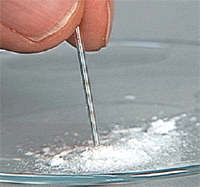 |
|
Tap tube so sample falls to the bottom of the tube. |
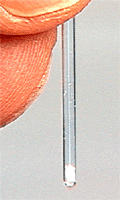 |
Impure samples have lower melting points than pure solids. You can use this information to determine the identity of an unknown through the mixed melting point method. You will be given an unknown from the list below. By determining the melting point of your unknown, you will be able to narrow the choices to three, based on the melting point ranges. You will then mix your unknown with EACH of the three possibilities. You can determine the melting point of each of the mixtures. In the two mixtures that contain two different compounds, you should see a drastic change in the melting point since the samples are not pure. One of the samples will contain only one compound, and this should be reflected by the melting point.
|
Compound
|
Melting
Point
|
|
acetanilide
|
113-115 °C |
|
p-aminobenzoic
acid
|
188-189
°C
|
|
camphoric
acid
|
183-186
°C
|
|
trans
-cinnamic acid
|
133-134 °C
|
|
malonic
acid
|
135-137 °C
|
|
p-nitrophenol
|
113-115 °C
|
|
resorcinol
|
110-113 °C
|
|
succinic
acid
|
187-189 °C
|
|
urea
|
133-135 °C
|
First obtain a sample of benzoic acid from your TA (about a spatula-tip). Grind the sample into a fine powder, and take two melting points, one fast, one slow (2 °C/min). Obtain your unknown from the stockroom, and grind this sample if necessary. Take two melting points of your known (one fast, one slow). You should now be able to determine the three possibilities for the identity of your unknown.
Mix a spatula-tip of your unknown with a spatula-tip of each of the three possible compounds. These samples should be well mixed to ensure the best results. Take the melting points of each of the mixtures, and use this information to determine the identity of your unknown,
| Samples of two compounds for mixed melting point. | 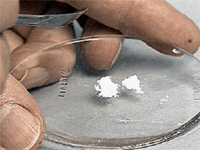 |
| Grind samples together. | 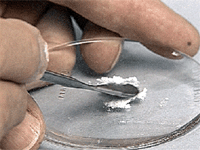 |
You should measure the melting point with the Thiele tube at your bench or the electrically heated melting point apparatus in the lab.
|
Thiele tube melting point apparatus |
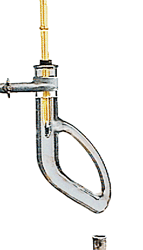 |
|
Electrically heated melting point apparatus |
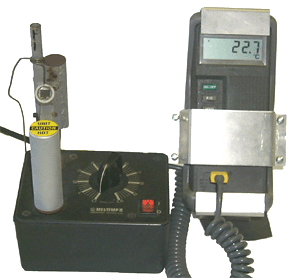 |
III. Report
Your report should include the following:
1. Reference to the procedure with any changes noted
2. Data for melting points of benzoic acid
3. Data for melting points of unknown sample
4. Data for the three mixtures
5. Identity of your unknown
6. Interpretation of data and a short conclusion
7. Use the data in figure 3.1 on page 108 of the textbook to answer these questions.
a. If a liquid with a composition of 80 mole % B were cooled what is the composition of the solid that forms first?b. If a liquid with a composition of 20 mole % B were cooled what is the composition of the solid that forms first?
c. If a solid with the composition 80 mole % A and 20 mole % B were heated what is the composition of the first liquid that forms?
d. If a solid with the composition 80 mole % A and 20 mole % B were heated what is the composition of the last solid to melt?
You should complete the web-based ChemNet tutorials on melting points before coming to the lab.